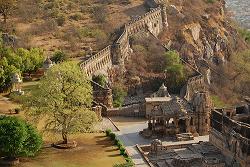
Welcome |
|
|
|
|
|
|
|
|
|
|
|
|
|
|
|
|
|
|
|
|
|
|
|
|
|
|
|
|
|
|
|
|
|
|
|
|
|
|
|
|
|
|
|
|
|
|
|
|
|
|
|
|
|
|
|
|
|
|
|
|
|
|
Chittorgarh Fort, Chittorgarh |
|
The most romantic name in Rajasthan is Chittaur. Chittorgarh was founded by Bappa Rawal in 8th century and is situated at an altitude of 408 mts above sea level. Chittorgarh is known for its massive fort which is 3 miles long and 495 feet high and also for Vijaystambha or the Tower of Victory. Standing tall in one of the oldest cities in Rajasthan, the Chittorgarh fort is perched on a 152 m high rocky hill. Chittorgah fort is the India's largest fort and the ultimate symbol of Rajput chivalry and pride.
The ascent to the Chittorgarh fort is led by a winding road
defended by seven fortified gateways or
'pols'.
|

|
|
There are 7 gateways to the main gate which are Padan
Pol, Bhairon Pol, Hanuman Pol, Ganesh Pol, Jorla Pol, Lakshman Pol and Ram
Pol. The Suraj Pol is the gate on the east. On the climb, there are two chhatris where Jaimal and
Kalla, heroes of the 1568 reign, fell during the struggle against
Akbar. Near the Padan Pol is the memorial of Rawat Bagh Singh who joined hands with King Vikramaditya to fight against Sultan Bahadur Shah of Gujarat when Chittor fort was attacked the second time. The Bhairon Pol is named in the memory of Bhairondas Solanki who also fought against Sultan Bahadur Shah in 1534 AD. The Hanuman
Pol, the Ram Pol and the Lakshman Pol have a temple in their vicinity. The Jorla Pol
has two adjacent gateways. |
|
|
|
|
History
of Chittorgarh Fort |
|
Chittor is more than a ruined citadel, it is a symbol. It stands for all
that was brave, true and noble in the Rajput tradition. Chittaur was
sacked three times, and on each occasion the rite of Jauhar was performed.
Jauhar is the mass self sacrifice in a sacred fire done by the women and
children of the Rajput kings to escape dishonour from the enemies. The
first was in 1303 when Allauddin Khilji, the Sultan of Delhi coveted the
famous Rajput beauty Rani Padmini whose face he had seen reflecting on a
mirror. Rani Padmini led the Jauhar rather than submit to dishonour. The
second was in 1533 when the Sultan of Gujarat attacked Bikramjeet of
Chittaur. Rani Karnavati, a Bundi Princess, take the jauhar in which many
women and children perished. Her own infant son, Udai Singh, was smuggled
out of Bundi to preserve the line. Udai Singh returned as a child to
Chittaur and he lived to inherit the throne of Chittaur. But his traumatic
childhood had taught him that discretion was certainly to be preferred to
valour, so when in 1567, Mughal emperor Akbar beseiged Chittaur, Udai
Singh escaped leaving its defence to two sixteen year old heroes, Jaimal
of Bednore and Patta of Kelwa. They died in true Rajput tradition after
the jauhar had been proclaimed and Akbar, taking no chances, razed the
fort to rubble. Chittaur was never inhabited again but it always asserted
the heroic spirit of Rajput warriors. Udai Singh built his new capital in
Udaipur.
It is believed that Bhim, the legendary figure of the Mahabharta, visited
this place to learn the secrets of immortality and became the disciple of
a saint, but his impatience to perform all the rites deprived him of his
goal, and out of sheer anger he stamped on ground creating water
reservoir, this reservoir is now known as Bhim Lat. It is also believed
that Bappa Rawal the legendary founder of the Sisodia clan, received
Chittaur in the middle of 8th century, as a part of the dowry after
marriage with the last Solanki princess. After that his descendants ruled
Mewar which stretched from Gujarat to Ajmer, upto the 16th century. |
|
|
|
Major Attraction |
|
Vijay Stambh or Tower of Victory :
An outstanding feature of the fort is the
Vijay Stambh or the Tower of Victory. This imposing 37 metres high structure with nine storeys is covered with exquisite sculptures of Hindu deities. It was built in 1440 AD by Maharana
Kumbha, a powerful ruler of Mewar to commemorate his victory over the Muslim rulers of Malawi and Gujarat. |
 |
|
Kirti
Stambh or Tower of Fame :
Kirti Stambh, a
22 meters high tower was built by a wealthy Jain
merchant in the 12th century AD. This tower is
dedicated to Adinathji, the first of the Jain
Tirthankaras and is decorated with figures of the
Jain pantheon.
|
|
|
|
|
|
|
|